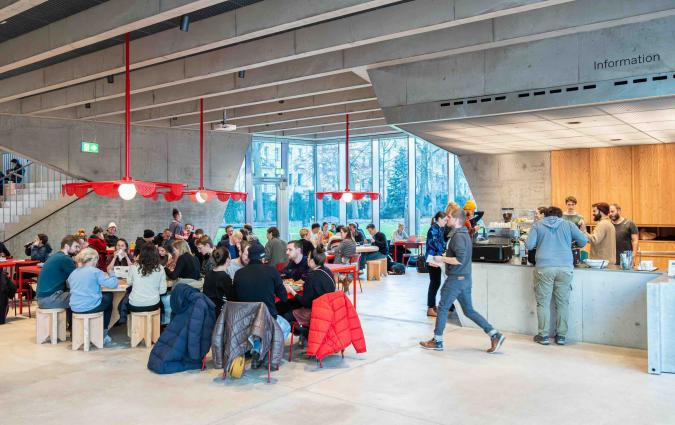Presentations from the Reuters Institute at the Future of Journalism Conference

The eighth Future of Journalism Conference held by Cardiff University's School of Journalism, Media and Culture (JOMEC) takes place on 23 and 24 September with the theme 'Overcoming obstacles in journalism'. Reuters Institute researchers will present papers on subjects covering trust in news and polarisation on WhatsApp. Read the abstracts of the papers below.
Putting platforms in their place: A cross-national study of how journalists understand trust in news in the digital environment
Amy Ross Arguedas, Camila Mont'Alverne, Sumitra Badrinathan, Benjamin Toff, Richard Fletcher, Rasmus Kleis Nielsen
In recent years, news organisations have become more and more dependent on platforms as a growing number of people encounter and consume news, often incidentally, through news aggregators, search engines, social media, or messaging applications (Fletcher & Nielsen, 2017; Nielsen & Ganter, 2017). Recent research has started to explore how the changing distribution and consumption of news via platforms may affect audience trust in news, which has been declining in many countries around the world. However, we know relatively little about how journalists, editors, managers, and other practitioners think about these issues. This matters because newsroom perspectives on how digital platforms may be contributing to diminishing trust are likely to shape actions irrespective of whether these beliefs are backed by evidence or not. Moreover, as we argue in this paper, the potential role played by platforms cannot be understood independently from the political, social, and historical contexts in which media organizations are embedded—and the distinct news cultures that vary considerably from place to place.
This study uses a qualitative, comparative method, including countries in both the Global North and South, to examine differing views about the causes and consequences of trust and distrust in news worldwide from the perspectives of those who produce it. Based on in-depth interviews conducted in 2020 with more than 80 journalists and senior managers from media organisations in Brazil, India, the UK, and the US, we show how interviewees tend to see issues of trust as extending well beyond platforms, often viewing them as endemic to the uneven ways journalism has been practiced both online and offline in their home environments. In Brazil, these concerns point to a history of political clientelism and concentration of media power; in India, to more recent erosions in press freedoms and concerns about "paid news"; in the US, to concerns about cable news and its contribution to polarisation; and in the UK, to a tradition of tabloid newspapers with questionable editorial practices.
From the point of view of the practitioners interviewed, digital platforms offer challenges mixed with some opportunities for news organizations seeking to earn and sustain audience trust. Many interviewees were particularly pessimistic about the challenges. These include concerns about changing algorithms, which create uncertainty about the terms through which news organizations are able to reach and deepen relationships with audiences. More generally the unbundling of news further complicates efforts to carve out brand identities that highlight what many journalists see as their own distinct approaches to newsgathering and editorial accountability.
While some spoke of opportunities for platforms to offer spaces for interacting and engaging with audiences in new ways or to showcase the competitive advantages of their own reporting practices amidst the perceived proliferation of misinformation online, many saw platforms as just one piece of the puzzle to rebuilding trust. Most highlighted deeper concerns about how news media have historically operated in their countries—problems platforms may magnify. These findings are put in dialogue with a growing body of scholarship on “platformisation” (Nieborg & Poell, 2018; van Dijck, Poell, & de Waal, 2018) and journalism studies research on comparative media systems (Hallin & Mancini, 2004; Mancini, 2020; Müller, 2013).
Our findings speak to how concerns about trust in news are shaped by the growing contingency of journalism on platforms and their infrastructures, but also how levels of trust in news continue to involve complex dynamics that transcend platforms and involve the broader media systems in which journalism is practiced. Given the complexity of trust as a social phenomenon, the platformisation of news cannot be understood without grappling with the relationship between trust in news and these additional factors at the media system level. These include the structure of media markets (e.g., the relative importance of television, print, and online sources of news), the role of the state (e.g., as funder or as regulator), the degree of political parallelism (e.g., political partisanship of audiences or extent of political orientation of content), and the level of journalistic professionalisation in each country (e.g., extent to which there are shared journalistic norms). Each may contribute in different ways to the impact of platforms on attitudes toward news but are likely to vary from one country to the next. We believe this more holistic understanding of the role of platforms is needed in order to best tailor solutions.
Audience polarisation and WhatsApp use: Evidence from mobile navigation data in Spain during the first COVID-19 national lockdown
Sílvia Majó-Vázquez, María Victoria Mas, Ana S. Cardenal, Iván Lacasa
The popularity of messaging apps, like WhatsApp, to access news has boomed. In 2020, national lockdowns amid the Covid-19 pandemic exacerbated this trend (Nic Newman, Fletcher, Schulz, Andi, & Nielsen, 2020). However, the growing use of WhatsApp is combined with the scarce research done so far to understand how messaging apps shape news consumption habits in times when they have become increasingly central to our media systems. In this study, we aim to provide evidence on 1) the level of polarisation of news audiences in messaging apps like Whatsapp and 2) the moderating role of populist attitudes in news consumption referred by WhatsApp.
To do so, we will follow a two-fold strategy. Firstly, we will investigate the diversity of sources accessed through the messaging app –relative to other side-doors to news like search engines, or social networks– to measure segmentation. We will also assess whether news diets become more polarised as the level of use of WhatsApp as referral to news increase. In this study, we use audience polarisation to refer to the extent that individuals navigate the news ecosystem along partisan lines. Previous research shows that news among more homogenous groups are frequently shared in messaging apps (Kalogeropoulos, 2018). Consistently, we expect that those citizens who use WhatsApp more frequently to navigate the online news domain will have less diverse and hence, more segmented news diets (Fletcher, 2019; Hameleers, Bos, & de Vreese, 2017). Additionally, the level of audience polarisation will also be measured against the type of news media more frequently referred by the messaging app. Based on previous evidence, we should expect that alternative media or digital-born news sites will be more frequently accessed via Whatsapp than legacy news outlets (Stier, Kirkizh, Froio, & Schroeder, 2020). Secondly, since populist attitudes have been strongly associated to the use of messaging apps to get news information, mainly to bypass mainstream media, we will test the moderation effects of populist attitudes over the type of news diets associated to WhatsApp, and ultimately over audience polarisation.
Our data strategy includes a novel dataset containing mobile, desktop and survey data collected during the first month of the national lockdown in Spain in 2020. In total, we obtained data from a sample of 700 individuals in this country, which alongside Italy, suffered one of the strictest national lockdowns worldwide during the first wave of the Covid-19 pandemic. Harnessing the granularity of our data, our study will also inform the debate on news audience fragmentation by comparing the amount of news sources accessed on mobile devices more generally with those on desktop and ultimately, also offline as reported by our sample.
Spain is by far the European country with the highest level of usage of WhatsApp for accessing news. Over 36% of the population use it to keep up with news content. Yet, the sharp growth of WhatsApp for news has been concentrated mainly in Latin America and South East Asia, having Brazil (53%) at the top of the ranking (Nic Newman et al., 2020). Amid the growing popularity of WhatsApp though, concerns have been raised regarding the type of news consumption taking place in this walled sphere, mainly, after the messaging application has demonstrably enable the spread of hate speech and harassment mainly during elections (Chakrabarti, Stengel, & Solanki, 2018). With our data at hand, we will only be able to assess news consumption referred by WhatsApp and hence, we will not be able to discern the patterns of news consumption taking place within the app. Yet, we believe that the analysis of news content referred by WhatsApp is a useful proxy to better understand the role of the messaging app in driving overall news consumption patterns and ultimately in mediating the democratic debate. Moreover, we will contribute to the debate about audience polarisation online that so far has been mainly concentrated in studying desktop navigation patterns mainly in US and northern Europe.







